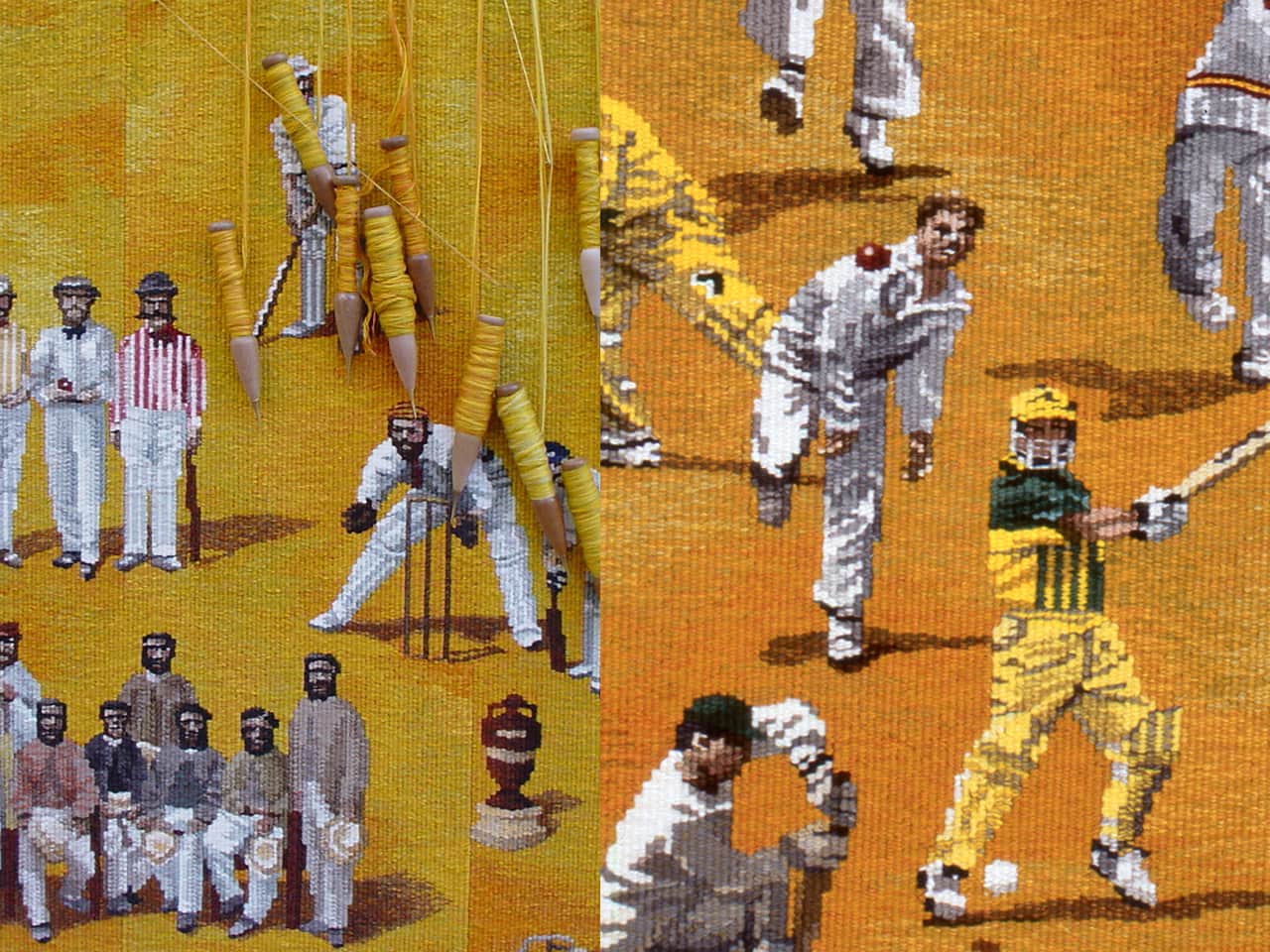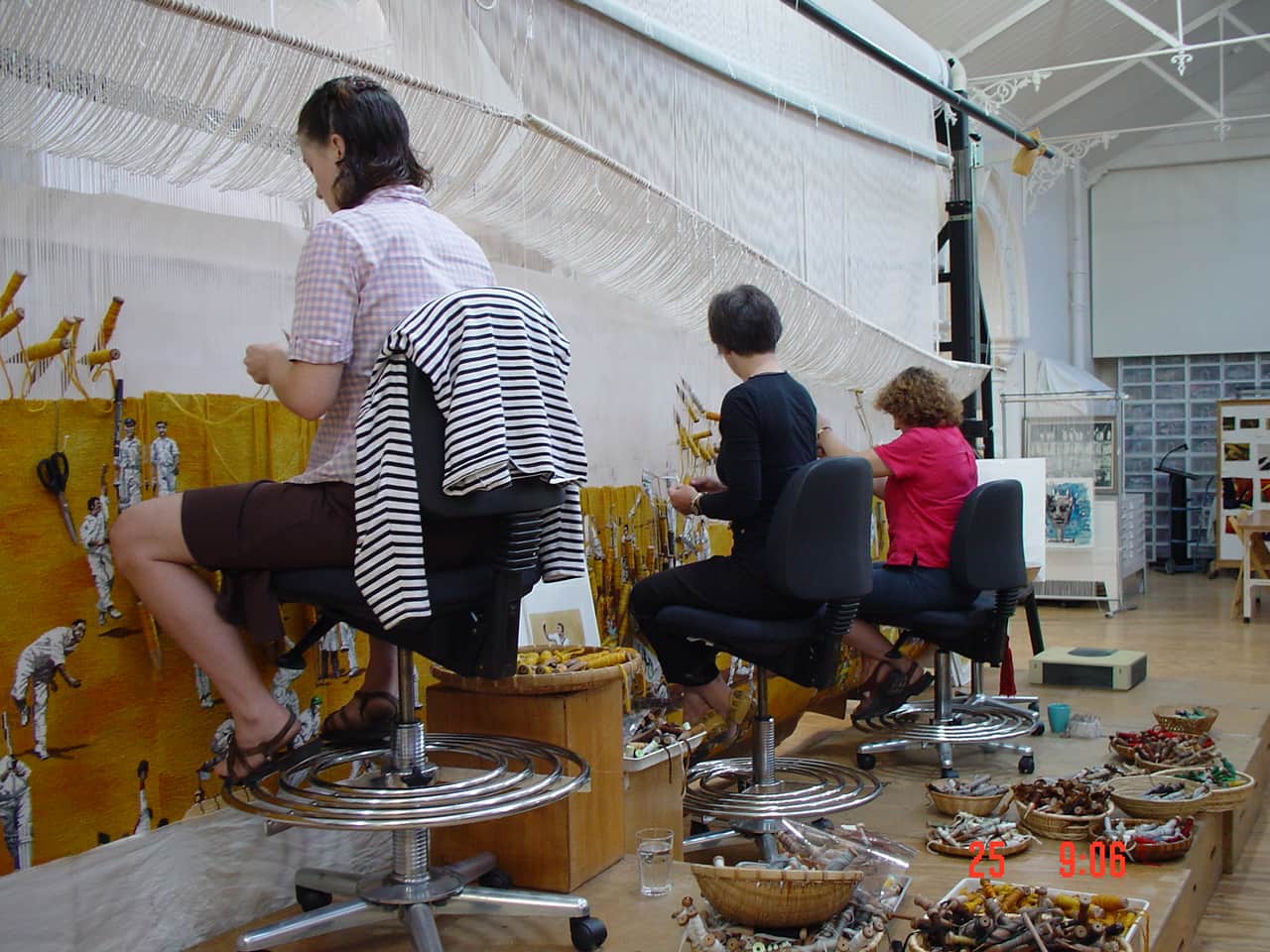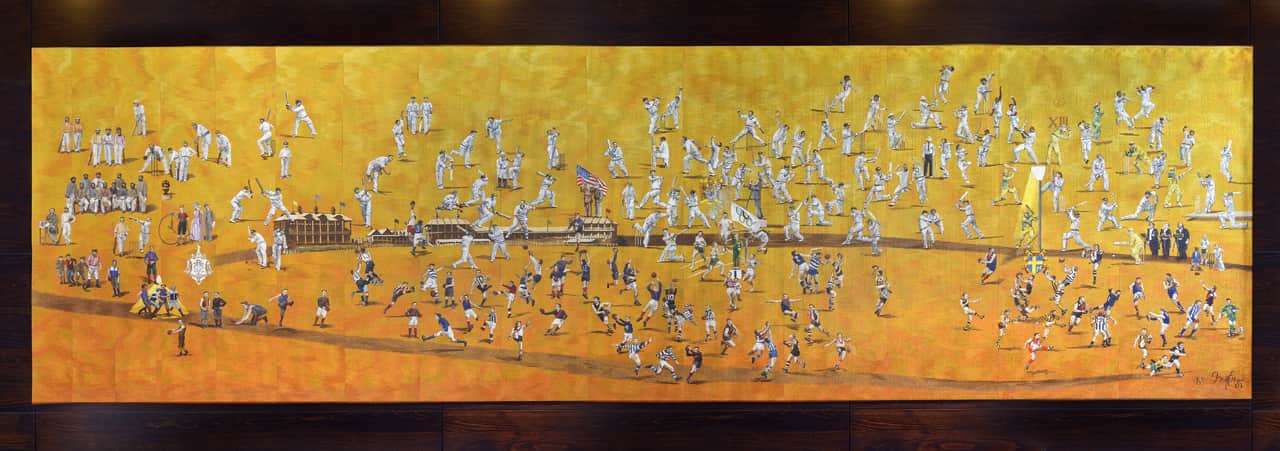


To celebrate the Melbourne Cricket Ground’s 150th anniversary, the Melbourne Cricket Club tapestry, designed by Robert Ingpen AM was woven by the ATW in 2002.
The monumental tapestry, measuring 2.00 x 7.00m, depicts key members of the Melbourne Cricket Club (MCC). Placed in chronological order, the figures depicted range from the MCC’s first president, Frederick Powlett, to champion Australian batsman-keeper Adam Gilchrist and Socceroo Kevin Muscat, who kicked Australia’s only goal in its 1-0 victory over Uruguay in a 2001 World Cup qualifying match.
Included are some of the greats of football and cricket, memorable sporting events such as the 1956 Olympic Games and Austral Wheel Races and other notable occasions like royal and papal tours, Billy Graham’s Crusade and the performance by the Three Tenors.
Ingpen painted the figures individually and then painted a broader yellow / orange canvas, allowing the weavers to position the figures as the tapestry developed on the loom.
The tapestry hangs proudly outside the Long Room at the MCG, where members and visitors can admire and identify those who have made a significant contribution to what the MCG is today.
Robert Ingpen is represented by Melaleuca Gallery in Victoria.
Reg Mombassa playfully captured Sydney suburbs in his design Bush suburbs, which was translated into a tapestry by the ATW in 2002.
Mombassa (AKA. Chris O’Doherty) is a painter, printmaker and designer well known to Australian audiences, not only through his design work for the lifestyle label Mambo but also as a former member of the band Mental As Anything. His imagery depicts suburban environments and the outback as well as iconic Australian views such as backyard barbeques. Bush suburbs is based on an amalgam of suburbs in Sydney, and the scene reflects a charmed world of perfect order, each element merrily – if not comically – in its place. The stereotyped suburban bungalows are adaptations of the houses Reg remembers as a child that his father built.
The design for this tapestry was selected because of the qualities it shares both with the great tapestries of the past, and the grand mural paintings of Stanley Spencer (who also drew inspiration from medieval tapestries). The flat picture plane, the firmly articulated graphic nature of the work, its decorative and narrative qualities, and its powerful representation of everyday life, have all made for a strong and moving tapestry on a mural scale.
Reg Mombassa is represented by Watters Gallery in Sydney.
Celebration, designed by David Larwill in 1999, was commissioned by the Government of Victoria and the Victorian Arts Centre Trust and gifted to Singapore’s Esplanade Performing Arts Centre (EPAC), to mark their official opening in 2001.
Larwill began painting in 1979. His joyful use of colour and form, and unique child-like freshness has seen him dubbed as one of the leading figurative expressionists in Australia.
EPAC desired a tapestry that would evoke a sense of celebrating the arts. The design needed to portray a powerful image, that would be eye-catching, taking into consideration that the tapestry would be viewed from a distance, hung in a large space approximately 3 metres from the floor. The resultant design sees the figures, that are synonymous with Larwill’s style, bursting forth from a vibrant red background.
The three weavers working on this project focused on maintaining the vibrancy and energy of Larwill’s original design. The tonal similarities of the design, provided through complex colour mixing, posed a challenge for the weavers. This difficulty was overcome by selecting more saturated shades of colour and playing cotton off against wool to create a surface texture. 13 strands of yarn were wound on each bobbin used.
Rising suns over Australia Felix was the first of several tapestries designed by John Olsen AO OBE and woven by the ATW in 1997.
After working with tapestry workshops in France and Portugal in the 1960s, Olsen found the work of ATW weavers to be world-class and has been a steadfast supporter of the ATW ever since. Olsen is widely considered to be one of Australia’s most important living artists. He is known for his lyrical drawings and paintings that feature native Australian flora and fauna. His works are constructed with multiple meandering lines, energetic life-forms and the rich colours that make up the Australian landscape.
Rising suns over Australia Felix, commissioned by the Department of Foreign Affairs and Trade, was inspired on a return flight to Australia, at the exact moment when Olsen witnessed a sunrise and saw the ascending orb gradually illuminate the expansive land below. The scene is split into two distinct halves – sky and land – but in both realms the surface is dappled, suggesting the luminosity of the dawn scene. The monumental scale of the tapestry effectively conjures the vastness of the Australian continent.
Olsen’s work is housed in Olsen Gallery and has been collected widely by national and international institutions.
In 1996 Wamungku- My Mother’s Country, designed by Ginger Riley Munduwalawala, was translated into tapestry. Munduwalawala (c1937-2002) was a member of the Mara Community from the Gulf country in Arnhem Land in the Northern Territory.
For many years Munduwalawala worked as a stockman on Nutwood Downs Station and, while travelling, met the well-known Indigenous artist Albert Namatjira, an encounter that was to influence his artistic development.
Munduwalawala’s large-scale tapestry Wamungku, My Mother’s Country was commissioned by the Department of Foreign Affairs and Trade in Canberra. The image is replete with references to Munduwalawala’s ancestral land on the Limmen Bight River in the Gulf country. The scene depicts a red sky and the symbolically important Four Archers, which represent hill formations in the Limmen Bight landscape, relating to stories of the creation myth. The image also includes animal totems such as kangaroos, snakes and sea eagles. One of the totems depicted repeatedly across the image –the white-breasted sea eagle – was the subject of an earlier, smaller tapestry woven by the Workshop. The sea eagle, known as Ngak Ngak in Munduwalawala’s native language, often appeared in his paintings as an emblem of vigilance, a totem keeping protective watch over his beloved homeland.